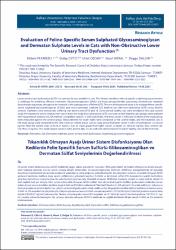Evaluation of feline-specific serum sulphated glycosaminoglycan and dermatan sulphate levels in cats with non-obstructive lower urinary tract dysfunction
Künye
PEKMEZCİ D,ÖZCAN Ü,MERAL Y,DALĞIN D,CIFTCI G (2021). Evaluation of Feline-Specific Serum Sulphated Glycosaminoglycan and Dermatan Sulphate Levels in Cats with Non-Obstructive Lower Urinary Tract Dysfunction. Kafkas Üniversitesi Veteriner Fakültesi Dergisi, 27(3), 331 - 337. Doi: 10.9775/kvfd.2021.25375.Özet
Lower urinary tract dysfunction (LUTD) is a commonly seen problem in cats. This chronic condition with no specific underlying cause remainsa challenge for achieving eff ective treatment. Glycosaminoglycans (GAGs) are linear polysaccharides possessing characteristic repeateddisaccharide sequences, thought to be involved in the pathogenesis of feline LUTD. The aim of the present study is to evaluate feline-specificserum sulphated glycosaminoglycan (S-GAG) and serum dermatan sulphate (DS) levels in cats with non-obstructive LUTD versus healthycontrols. Eighteen client-owned cats suff ering non-obstructive LUTD and 16 client-owned healthy cats were enrolled in this case-controlstudy. Pre-treatment serum samples from cats in both the study (non-obstructive LUTD cats) and control (healthy cats) groups were analysedwith “Quantitative Sandwich ELISA method” using feline-specific S-GAG and DS kits. The mean serum S-GAG and DS levels of the study groupwere measured against the control group. Measurements for study males were compared to the control males, and the neutered cats inthe study group were compared to the intact ones in control group. Cats in study group had lower serum S-GAG concentrations (3.52±0.26ng/mL) than the control ones (3.93±0.27 ng/mL). Cats in study group had higher serum DS levels (27.20±6.62 ng/mL) than control cats(16.79±5.21 ng/mL). This study reports serum S-GAG and DS data in cats with non-obstructed LUTD and in healthy cats for the first time. Alt üriner sistem disfonksiyonu (AÜSD) kedilerde yaygın olarak görülen bir sorundur. Altta yatan belirli bir nedeni olmayan bu kronik durum, etkili tedaviye ulaşmak için bir zorluk olmaya devam etmektedir. Glikozaminoglikanlar (GAG’lar), AÜSD’nun patogenezinde rol oynadığı düşünülen karakteristik tekrarlanan disakkarit sekanslarına sahip doğrusal polisakkaritlerdir. Bu çalışmanın amacını, tıkanıklık olmayan AÜSD gösteren kedilerde, kedilere özgü serum sülfatlanmış glikozaminoglikan (S-GAG) ve dermatan sülfat (DS) düzeylerinin sağlıklı kontrollere göre karşılaştırılması oluşturmuştur. Bu vaka kontrol çalışmasında, tıkanıklık olmayan AÜSD’dan mustarip, sahipli on sekiz kedi ile sahipli 16 adet sağlıklı kedi yer almıştır. Hem çalışma (tıkanıklık olmayan AÜSD kediler) hem de kontrol (sağlıklı kediler) grubundaki kedilerden alınan tedavi öncesi serum örnekleri, kedilere özgü S-GAG ve DS kitleri kullanılarak “Kantitatif Sandviç ELISA yöntemi” ile analiz edilmiştir. Çalışma ve kontrol gruplarına ait tüm kediler ile, çalışma ve kontrol grubundaki erkek kediler ve her iki gruptaki sterilize edilmiş kedilerin ortalama serum S-GAG ve DS seviyeleri karşılaştırılmıştır. Çalışma grubunun serum S-GAG konsantrasyonları (3.52±0.26 ng/mL) kontrol grubuna kıyasla daha düşük (3.93±0.27 ng/mL) bulunmuştur. Tersine çalışma grubu serum DS seviyeleri ise (27.20±6.62 ng/mL) kontrol grubuna (16.79±5.21 ng/ mL) oranla yüksek bulunmuştur. Bu çalışma, tıkanma olmayan AÜSD’si kedilerde ve sağlıklı kedilerde ilk kez serum S-GAG ve DS verilerini bildirmektedir.
















